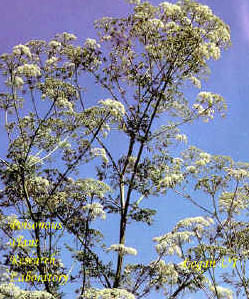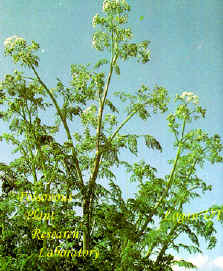| Poison Hemlock (Conium maculatum) |

|
Poison-hemlock has white flowers that grow in small erect clusters. Each flower develops into a green, deeply ridged fruit that contains several seed. After maturity, the fruit turns grayish brown. Poison-hemlock starts growing in the early spring. It usually grows for 2 years, but in favorable locations it may be a perennial. Roots of poison-hemlock may easily be mistaken for wild parsnips. Poison-hemlock grows along fence lines, in irrigation ditches, and in other moist, waste places. It may be 2 to 3 meters tall. The hollow stem usually is marked with small purple spots. Leaves are delicate, like parsley, and it has a white taproot. Poison-hemlock is a biennial in the parsnip or wild carrot family.
All parts of poison-hemlock (leaves, stem, fruit, and root) are poisonous. Leaves are especially poisonous in the spring, up to the time the plant flowers. Fresh leaves are unpalatable, so livestock seldom eat hemlock when other feed is available. The toxic compounds are coniine, g-coniceine, and related piperidine alkaloids. People may be poisoned by eating any part of a hemlock plant. Often, poisoning occurs after the victim confuses hemlock root with wild parsnips, hemlock leaves with parsley, or hemlock seed with anise. Whistles made from hollow Where and When It Grows How It Affects Livestock Skeletal deformities or cleft palate may be induced in offspring of cows, sheep, goats, and pigs that eat poison-hemlock during gestation. Susceptible stages of gestation when animals should not be exposed to this plant include 40 to 70 days in cows and 30 to 60 days in sheep, goats, and pigs. Palate and skeletal deformities in calves are indistinguishable from the lupine-induced crooked calf disease. Signs and Lesions of Poisoning and 70 days gestation How to Reduce Losses Poison-hemlock may be controlled by treating plants before they begin to bud with 2,4-D plus dicamba (1 kg + 0.5 kg ai/Ac). Repeat applications may be needed. Follow all precautions for handling herbicides. |

 Poison-hemlock grows throughout the United States. It is very toxic and sheep, cattle, swine, horses, and other domestic animals are poisoned by eating small amounts of green or dried plant. It is also extremely poisonous to humans. Poison-hemlock is sometimes confused with western water hemlock, a more deadly species, because the names are similar. Poison-hemlock is commonly called deadly hemlock, poison parsley, spotted hemlock, European hemlock, and California or Nebraska fern.
Poison-hemlock grows throughout the United States. It is very toxic and sheep, cattle, swine, horses, and other domestic animals are poisoned by eating small amounts of green or dried plant. It is also extremely poisonous to humans. Poison-hemlock is sometimes confused with western water hemlock, a more deadly species, because the names are similar. Poison-hemlock is commonly called deadly hemlock, poison parsley, spotted hemlock, European hemlock, and California or Nebraska fern.